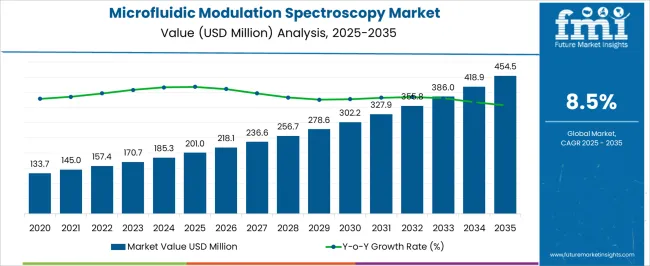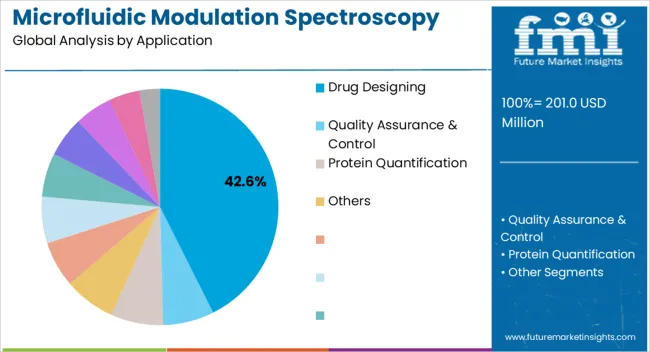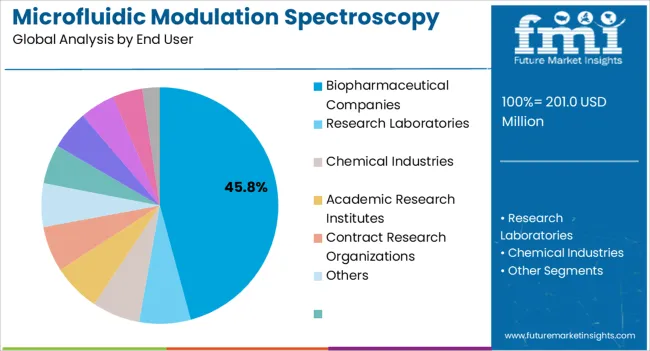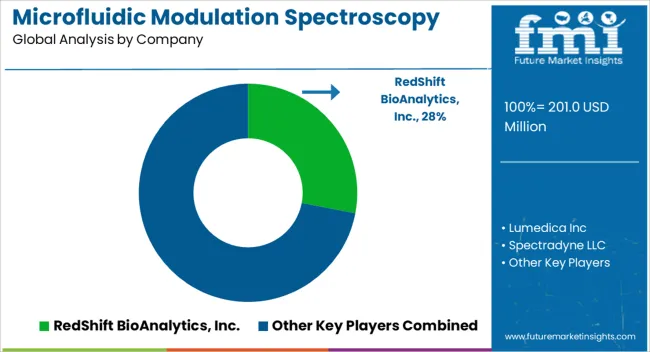The Microfluidic Modulation Spectroscopy Market is estimated to be valued at USD 201.0 million in 2025 and is projected to reach USD 454.5 million by 2035, registering a compound annual growth rate (CAGR) of 8.5% over the forecast period.

| Metric | Value |
|---|---|
| Microfluidic Modulation Spectroscopy Market Estimated Value in (2025 E) | USD 201.0 million |
| Microfluidic Modulation Spectroscopy Market Forecast Value in (2035 F) | USD 454.5 million |
| Forecast CAGR (2025 to 2035) | 8.5% |
The Microfluidic Modulation Spectroscopy market is witnessing significant expansion as biopharmaceutical and research organizations increasingly demand precise, high-resolution analytical techniques for molecular characterization. The current market scenario is defined by the rising adoption of advanced microfluidic platforms that integrate spectroscopy for real-time monitoring of biomolecular interactions, protein stability, and formulation optimization.
Growth is being driven by increasing investments in drug discovery and development processes, alongside regulatory pressures to ensure higher quality and safety in biologics. The technology’s ability to reduce sample consumption, accelerate experimental timelines, and deliver reproducible results has enhanced its value proposition across research and industrial applications.
Future growth opportunities are expected to be shaped by the expansion of personalized medicine initiatives, rising biologics production, and the adoption of automated, high-throughput analytical workflows As biopharmaceutical innovation intensifies, the Microfluidic Modulation Spectroscopy market is positioned to provide scalable, precise, and cost-effective solutions that support accelerated drug development and enhanced quality control.
The microfluidic modulation spectroscopy market is segmented by application, end user, and geographic regions. By application, microfluidic modulation spectroscopy market is divided into Drug Designing, Quality Assurance & Control, Protein Quantification, and Others. In terms of end user, microfluidic modulation spectroscopy market is classified into Biopharmaceutical Companies, Research Laboratories, Chemical Industries, Academic Research Institutes, Contract Research Organizations, and Others. Regionally, the microfluidic modulation spectroscopy industry is classified into North America, Latin America, Western Europe, Eastern Europe, Balkan & Baltic Countries, Russia & Belarus, Central Asia, East Asia, South Asia & Pacific, and the Middle East & Africa.

The Drug Designing application segment is projected to hold 42.60% of the Microfluidic Modulation Spectroscopy market revenue in 2025, making it the leading application. This dominance has been influenced by the growing emphasis on rational drug design and the need to understand protein-ligand interactions with high accuracy. The segment’s growth has been supported by the ability of microfluidic modulation spectroscopy to deliver rapid, reproducible measurements while using minimal sample volumes, which is critical for early-stage drug discovery.
Adoption has been further enhanced by the increasing integration of spectroscopy with computational modeling, enabling precise assessment of molecular stability, binding kinetics, and formulation optimization. Pharmaceutical research laboratories benefit from streamlined workflows that reduce time-to-market and minimize experimental errors.
Additionally, the segment is being favored due to regulatory requirements for robust molecular characterization during drug development, which has further propelled investment in advanced analytical platforms The continued expansion of biologics pipelines and targeted therapeutics is expected to sustain the leadership of this application segment over the coming years.

The Biopharmaceutical Companies end-use segment is expected to account for 45.80% of the Microfluidic Modulation Spectroscopy market revenue in 2025, making it the largest end-user segment. Growth in this segment is being driven by the increasing reliance on advanced analytical techniques for biologics and protein therapeutics development. The segment’s prominence has been facilitated by the technology’s capability to provide real-time molecular analysis, enhance formulation stability studies, and support quality assurance processes while minimizing sample requirements.
Adoption has been accelerated by the rising complexity of biologics and personalized therapies, which demand highly precise, scalable, and automated measurement solutions. The use of microfluidic modulation spectroscopy allows biopharmaceutical companies to optimize R&D timelines, reduce experimental costs, and ensure compliance with stringent regulatory standards.
Furthermore, ongoing expansion in biopharmaceutical production, along with the trend toward continuous manufacturing and high-throughput screening, has strengthened the segment’s growth The segment is expected to maintain its market leadership as the biopharmaceutical industry continues to prioritize efficiency, accuracy, and innovation in drug development workflows.
Microfluidic modulation spectroscopy is an emerging technique of spectroscopy for analysing the secondary structure of the protein. The company named RedShift BioAnalytics launched a product named AQS3 which uses the patented technique of microfluidic modulation spectroscopy.
This technique uses mid-infrared laser spectroscopy in microfluidics environment and uses advanced signal processing to measure the secondary structure of proteins. This type of innovative spectroscopy is implemented to measure and quantify the protein along with its stability, similarity, structure and aggregate formation. This technique can be implemented on a broad variety of conditions and is sensitive and precise. The function of the protein changes by conformational change and this could be an influencing factor in quality control of proteins such as antibodies and enzymes manufacturing companies.
Such structural changes can be precisely and sensitively detected by the microfluidic modulation spectroscopy. It also aids researchers to find stable and suitable antibodies. The advancements and innovative product launches in medical and life science in the past years is expanding the understanding of biological systems at the molecular level and generates more opportunities in the microfluidic modulation spectroscopy. Therefore, a constant incremental opportunity for the manufacturing company can be anticipated during the forecast period.

| Country | CAGR |
|---|---|
| China | 11.5% |
| India | 10.6% |
| Germany | 9.8% |
| France | 8.9% |
| UK | 8.1% |
| USA | 7.2% |
| Brazil | 6.4% |
The Microfluidic Modulation Spectroscopy Market is expected to register a CAGR of 8.5% during the forecast period, exhibiting varied country level momentum. China leads with the highest CAGR of 11.5%, followed by India at 10.6%. Developed markets such as Germany, France, and the UK continue to expand steadily, while the USA is likely to grow at consistent rates. Brazil posts the lowest CAGR at 6.4%, yet still underscores a broadly positive trajectory for the global Microfluidic Modulation Spectroscopy Market. In 2024, Germany held a dominant revenue in the Western Europe market and is expected to grow with a CAGR of 9.8%. The USA Microfluidic Modulation Spectroscopy Market is estimated to be valued at USD 69.9 million in 2025 and is anticipated to reach a valuation of USD 140.4 million by 2035. Sales are projected to rise at a CAGR of 7.2% over the forecast period between 2025 and 2035. While Japan and South Korea markets are estimated to be valued at USD 9.8 million and USD 5.3 million respectively in 2025.

| Item | Value |
|---|---|
| Quantitative Units | USD 201.0 Million |
| Application | Drug Designing, Quality Assurance & Control, Protein Quantification, and Others |
| End User | Biopharmaceutical Companies, Research Laboratories, Chemical Industries, Academic Research Institutes, Contract Research Organizations, and Others |
| Regions Covered | North America, Europe, Asia-Pacific, Latin America, Middle East & Africa |
| Country Covered | United States, Canada, Germany, France, United Kingdom, China, Japan, India, Brazil, South Africa |
| Key Companies Profiled | RedShift BioAnalytics, Inc., Lumedica Inc, Spectradyne LLC, Insplorion AB, Fluidion SAS, and Biolin Scientific AB |
The global microfluidic modulation spectroscopy market is estimated to be valued at USD 201.0 million in 2025.
The market size for the microfluidic modulation spectroscopy market is projected to reach USD 454.5 million by 2035.
The microfluidic modulation spectroscopy market is expected to grow at a 8.5% CAGR between 2025 and 2035.
The key product types in microfluidic modulation spectroscopy market are drug designing, quality assurance & control, protein quantification and others.
In terms of end user, biopharmaceutical companies segment to command 45.8% share in the microfluidic modulation spectroscopy market in 2025.






Our Research Products

The "Full Research Suite" delivers actionable market intel, deep dives on markets or technologies, so clients act faster, cut risk, and unlock growth.

The Leaderboard benchmarks and ranks top vendors, classifying them as Established Leaders, Leading Challengers, or Disruptors & Challengers.

Locates where complements amplify value and substitutes erode it, forecasting net impact by horizon

We deliver granular, decision-grade intel: market sizing, 5-year forecasts, pricing, adoption, usage, revenue, and operational KPIs—plus competitor tracking, regulation, and value chains—across 60 countries broadly.

Spot the shifts before they hit your P&L. We track inflection points, adoption curves, pricing moves, and ecosystem plays to show where demand is heading, why it is changing, and what to do next across high-growth markets and disruptive tech

Real-time reads of user behavior. We track shifting priorities, perceptions of today’s and next-gen services, and provider experience, then pace how fast tech moves from trial to adoption, blending buyer, consumer, and channel inputs with social signals (#WhySwitch, #UX).

Partner with our analyst team to build a custom report designed around your business priorities. From analysing market trends to assessing competitors or crafting bespoke datasets, we tailor insights to your needs.
Supplier Intelligence
Discovery & Profiling
Capacity & Footprint
Performance & Risk
Compliance & Governance
Commercial Readiness
Who Supplies Whom
Scorecards & Shortlists
Playbooks & Docs
Category Intelligence
Definition & Scope
Demand & Use Cases
Cost Drivers
Market Structure
Supply Chain Map
Trade & Policy
Operating Norms
Deliverables
Buyer Intelligence
Account Basics
Spend & Scope
Procurement Model
Vendor Requirements
Terms & Policies
Entry Strategy
Pain Points & Triggers
Outputs
Pricing Analysis
Benchmarks
Trends
Should-Cost
Indexation
Landed Cost
Commercial Terms
Deliverables
Brand Analysis
Positioning & Value Prop
Share & Presence
Customer Evidence
Go-to-Market
Digital & Reputation
Compliance & Trust
KPIs & Gaps
Outputs
Full Research Suite comprises of:
Market outlook & trends analysis
Interviews & case studies
Strategic recommendations
Vendor profiles & capabilities analysis
5-year forecasts
8 regions and 60+ country-level data splits
Market segment data splits
12 months of continuous data updates
DELIVERED AS:
PDF EXCEL ONLINE
Microfluidics Market Analysis - Technology, Trends & Forecast 2025 to 2035
High Precision Microfluidic Pump Market Size and Share Forecast Outlook 2025 to 2035
Neuromodulation Devices Market
Pulse Width Modulation Controllers Market Size and Share Forecast Outlook 2025 to 2035
Tibial Neuromodulation Devices Market Size and Share Forecast Outlook 2025 to 2035
Implantable Tibial Neuromodulation Market Forecast and Outlook 2025 to 2035
Spectroscopy Equipment and Supplies Market Growth – Trends & Forecast 2018-2027
Spectroscopy Intravascular Imaging System Market
IR Spectroscopy Market Analysis - Growth & Forecast 2025 to 2035
THz Spectroscopy Kit Market Size and Share Forecast Outlook 2025 to 2035
Atomic Spectroscopy Market Size and Share Forecast Outlook 2025 to 2035
Process Spectroscopy Market Analysis - Size, Share, and Forecast Outlook 2025 to 2035
Molecular Spectroscopy Market Insights - Growth & Forecast 2025 to 2035
Fluorescence Spectroscopy Market Size and Share Forecast Outlook 2025 to 2035
Bioimpedance Spectroscopy Market – Trends & Forecast 2025 to 2035
Optical Emission Spectroscopy Market Report – Trends 2019-2027
Atomic Absorption Spectroscopy Market Size and Share Forecast Outlook 2025 to 2035
X-ray Photoelectron Spectroscopy Market Insights - Growth & Forecast 2024 to 2034
Angle-Resolved Photoemission Spectroscopy Market Size and Share Forecast Outlook 2025 to 2035

Thank you!
You will receive an email from our Business Development Manager. Please be sure to check your SPAM/JUNK folder too.
Chat With
MaRIA